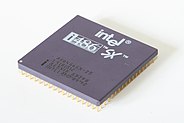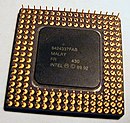i486SX
Thei486SXwas a microprocessor originally released byIntelin 1991. It was a modified Inteli486DXmicroprocessor with itsfloating-point unit (FPU)disabled. It was intended as a lower-cost CPU for use in low-end systems—selling for US$258—adapting theSXsuffix of the earlieri386SXin order to connote a lower-cost option. However, unlike the i386SX, which had a 16-bit external data bus and a 24-bit external address bus (compared to the fully 32-biti386DX, its higher-cost counterpoint), the i486SX was entirely 32-bit.[1]: 117 The Intel486 SX-20 CPU can perform up 20 MIPS at 25 MHz while this can also perform 70% faster than the 33 MHz Intel386 DX with external cache.[2]
Overview
[edit]In the early 1990s, common applications, such as word processors and database applications, did not need or benefit from a floating-point unit, such as that included in thei486,introduced in 1989. Among the rare exceptions wereCADapplications, which could often simulate floating point operations in software, but benefited from a hardware floating point unit immensely.[3]AMD had begun manufacturing itsi386DXclone, theAm386,which was faster than Intel's.[4]To respond to this new situation, Intel wanted to provide a lower costi486CPU for system integrators, but without sacrificing the better profit margins of a full i486. Intel were able to accomplish this with the i486SX, the first revisions of which were practically identical to the i486 but with its floating-point unit internally wired to be disabled.[1]: 116–117 [5]: 162–164 [a]The i486SX was introduced in mid-1991 at 20 MHz, one core with 8kb of cache in apin grid array (PGA)package.[3]There were low-power version of 16, 20, and 25 MHz Intel486 SX microprocessors. They were available USD $235, USD $266, and USD $366 for these frequency range respectfully. All pricing were in quantities of 1,000 pieces.[7]Later versions of the i486SX, from 1992 onward, had the FPU entirely removed for cost-cutting reasons and comes in surface-mount packages as well.[1]: 117
The first computer system to ship with an i486SX on its motherboard from the factory wasAdvanced Logic Research's Business VEISA 486/20SX in April 1991.[8]Initial reviews of the i486SX chip were generally poor among technology publications and the buying public, who deemed it an example ofcrippleware.[1]: 117
Many systems allowed the user to upgrade the i486SX to a CPU with the FPU enabled. The upgrade was shipped as thei487,which was a full-blown i486DX chip with an extra pin. The extra pin prevents the chip from being installed incorrectly.[b]Although i486SX devices were not used at all when the i487 was installed, they were hard to remove because the i486SX was typically installed in non-ZIFsockets or in a plastic package that was surface mounted on the motherboard. LaterOverDriveprocessors also plugged into the socket and offered performance enhancements as well.[9]
Explanatory notes
[edit]- ^A long-standing rumor was that the first batches of the i486SX were i486 chips with defective floating-point units on their dies. However, Alex Witkowski, Intel alumnus and an engineer behind the i486SX, rejected this on theOS/2 Museumblog, writing that the floating-point units of the original i486 chip die to be converted to i486SX were never tested, and that only by grounding a certain bond wire in the CPUpackagewas this conversion accomplished.[6]
- ^The NC# pin (one of the standard 168 pins of the i486) was used to shut off the i486SX.[6]
References
[edit]- ^abcdRoss, Matthew J. (October 13, 1992)."486SX: The New Entry-Level PC".PC Magazine.11(17). Ziff-Davis: 114–257.
- ^Intel Corporation, "A Guide to the Intel Architecture", Microcomputer Solutions, January/February 1992, page 11
- ^abSlater, Michael (July 1991)."The new entry-level platform: Intel aims 486SX to gradually replace 386DX".Computer Shopper.11(7). SX2 Media Labs: 113 – via Gale.
- ^Caron, Jeremiah (May 20, 1991)."More punch per dollar spent".Computerworld.XXV(20). IDG Publications: 104 – via Google Books.
- ^Seymour, Jim (December 31, 1991)."486SX: Great for Intel, but What About You?".PC Magazine.10(22). Ziff-Davis: 170–238 – via Google Books.
- ^abNecasek, Michal (December 26, 2015)."Lies, Damn Lies, and Wikipedia".OS/2 Museum.RetrievedDecember 27,2015.
- ^Intel Corporation, "New Product Focus: Components: Modified Chips Cuts Portable Power Consumption", Microcomputer Solutions, November/December 1991, page 10
- ^Lavin, Paul (April 24, 1991)."World's first 486SX".PC User(157). EMAP Media: 33 – via Gale.
- ^"Microprocessor Types and Specifications".InformIT.Pearson. June 8, 2001. Archived fromthe originalon December 7, 2021.
External links
[edit]- Intel 80486SX images and descriptionsat cpu-collection.de
- Intel datasheets




